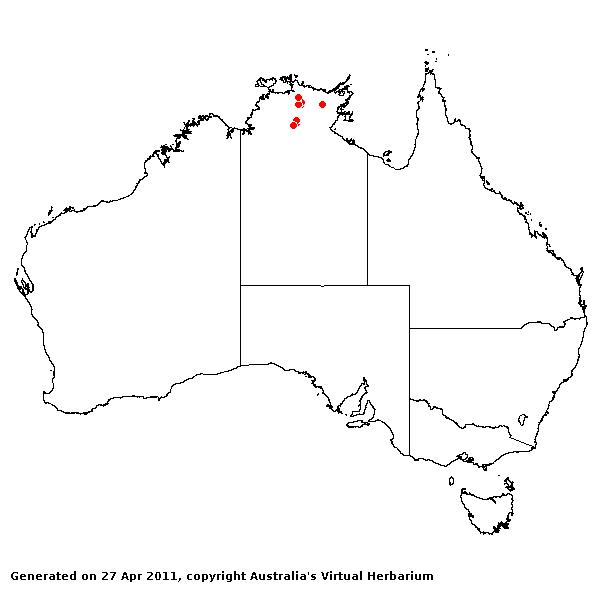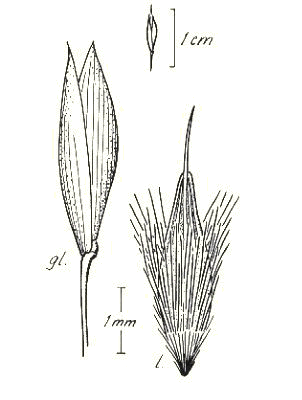Eriachne axillaris M. Lazarides. Austral.
Syst. Bot. 8: 368 (1995).
Classification. (GPWG 2001) : Subfamily Micrairoideae.
Eriachneae.
Type of Basionym or
Protologue Information: Australia: Northern Territory: Darwin and Gulf
District: Little Nourlangie Rock, 12.24S 132.48E, 18 Mar 1979, C.R. Dunlop
5103 (HT: CANB; IT: BRI, DNA, NT).
Key references
(books and floras): [2002] D.Sharp & B.K.Simon, AusGrass, Grasses of
Australia.
Illustrations:
[2005] K.Mallet (ed.), Flora of Australia 44B: Poaceae 3 (Fig.
28F-G).
Habit. Annual
or ephemeral. Culms erect or geniculately ascending, stature slender to
delicate, 15–25 cm tall, 6–7 -noded. Mid-culm internodes glabrous. Mid-culm
nodes pubescent. Lateral branches simple. Ligule a fringe of hairs, 0.3 mm
long. Leaf-blades straight, filiform, involute, 1–2.5 cm long, 1 mm wide.
Leaf-blade surface scabrous, glabrous or indumented.
Inflorescence.
Inflorescence compound, a panicle. Panicle ovate, 2–3 cm long, 1–2 cm wide.
Spikelets.
Spikelets pedicelled. Fertile spikelets 2-flowered, both fertile, comprising 2
fertile floret(s), without rachilla extension, ovate, laterally compressed, 3.5–4.3
mm long.
Glumes.
Glumes similar, thinner than fertile lemma. Lower glume elliptic, membranous,
much thinner on margins, without keels, 7–9 -nerved. Lower glume surface
glabrous. Lower glume apex muticous or mucronate. Upper glume elliptic, 3 mm
long, membranous, without keels, 7–9 -nerved. Upper glume surface smooth,
glabrous. Upper glume apex muticous or mucronate.
Florets.
Fertile lemma 2.9–4.3 mm long, without keel, 5 -nerved. Lemma surface
indumented. Lemma apex mucronate or awned, 1 -awned. Median (principal) awn
0.6–1 mm long overall. Palea 2 -nerved. Palea apex entire, muticous. Lodicules
present. Anthers 3. Grain 1.5–1.7 mm long.
Continental
Distribution: Australasia.
Australian
Distribution: Northern Territory.
Northern Territory:
Darwin & Gulf.
Notes.
Distinguished by its axillary and cleistogamous inflorescences; the terminal
panicles are overmature and lacking spikelets on both collections. Other
distinguishing features include filiform culms and blades, glabrous smooth
glumes, narrow florets longer than glumes with appressed lemma and palea,
shortly awned grooveless lemmas, entire pubescent palea, and strongly
compressed caryopis.
Endemic.
Known from two central northern localities in N.T. Growing in shallow sand on
sandstone outcrop and slope. Flowers and fruits chiefly Mar. (early- autumn),
extending to June (early- winter).



